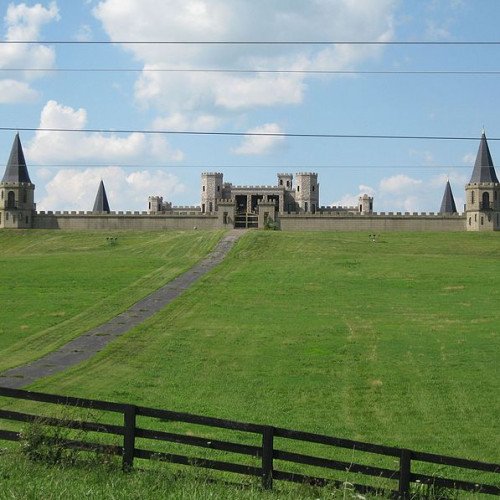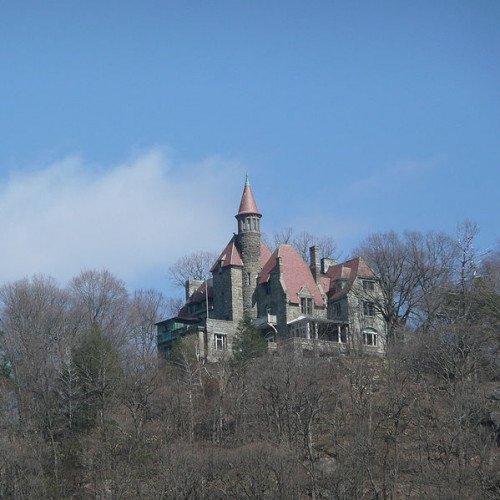Castles of "United States" CASTLE POST vs CASTLE ROCK

CASTLE POST
The Kentucky Castle, also known as Castle Post, Martin Castle and Versailles Castle, is a castle in Kentucky, located in Versailles, Kentucky, near Lexington, Kentucky, 201 Pisgah Pike near the Woodford County line, part of a 50 acres (20 ha) estate. It is visually situated off Lexington (Versailles) road. The Kentucky Castle overlooks the Elkhorn Creek watershed on the Woodford/Fayette county line. Construction began in 1969 by its original owners, and has since changed hands undergoing a major renovation in 2004. Today it operates as a bed and breakfast and special functions facility. As of 2017, new owners have focused on revitalization and remodels of the castle. The castle hosts special events, weddings, and has an operational farm-to-table restaurant inside. Construction on the castle was started by real estate developer Rex Martin and his wife Caroline Bogaert Martin in 1969, after they had returned from a trip to Germany and were inspired by the architecture and many famous buildings they had seen in Europe. The finished project was to have seven bedrooms, fifteen bathrooms, a fountain in the driveway, and a tennis court. In 1975, the Martins divorced and left the castle unfinished. Over the years, it became a popular oddity and roadside photo-op for tourists. Rex Martin listed it for sale in 1988, but died in 2003 without selling it. In 2003 the so-called "Martin Castle" was sold for 1.8 million dollars to Thomas R. Post, a lawyer from Miami who graduated from University of Kentucky, and the name was changed to "The Castle Post". It had been for sale for many years at a price rumored to be more than 3 million dollars, and there had been talks that it would be turned into a medieval-themed restaurant or a museum. On May 10, 2004, after months of renovations, an ugly mishap caused newly installed woodwork and wiring to catch fire in the main building. Post, who was at his home in Miami at the time, had already spent months renovating it but vowed to rebuild. Approximately twice the castle's original cost went towards the reconstruction project. Reconstruction was completed in Fall 2008. New additions include twelve luxury suites, a library, game room, music room, dining hall, ball room, swimming pool, formal garden, basketball court, bar, and tennis court. It is used as a tourist inn, fund raisers, weddings, special events, and corporate functions. It has sixteen bedrooms, four of which are in the outside turrets. In November 2010, the property was listed for sale at $30,000,000. Post said he would continue to operate it as an inn while it was listed. It was sold in 2017.
Statistics for this Xoptio

CASTLE ROCK
Castle Rock is the estate of former Illinois Central Railroad president William H. Osborn in Garrison, New York, United States. It sits on the hill of the same name, looking down on the Hudson River 620 feet (190 m) below. Visible from West Point across the river and traffic on NY 9D passing through Garrison, it has become one of the most recognizable man-made landmarks of the Hudson Highlands. The Osborn family, including paleontologist Henry Fairfield Osborn and his son, conservationist Henry Fairfield Osborn, Jr, has owned and lived in it since it was built by J. Morgan Slade in 1881 as a summer residence, although the original acreage has been subdivided considerably since then. In 1977 it was listed on the National Register of Historic Places. Most of the remaining land is now open to the public for hiking. In 1855 Osborn, who had been one of the charter officers of the Illinois Central two years earlier, visited the Highlands to take in the fresh air and scenic beauty of the area. He enjoyed his visit so much that he decided to buy the property where Castle Rock and its associated properties now stands. He and his family spent summers in Wing and Wing until the castle was completed the year before he retired from the railroad industry as president of the Chicago, St. Louis and New Orleans Railroad. He lived there until his death in 1894, devoting his time and money to philanthropic activities in New York. It was inherited by his son Henry Fairfield Osborn. Since it was intended as a retirement house, it needed to be expanded to accommodate the younger Osborn's wife and family. The library wing was added in 1906; most of Osborn's paleontological papers were written at Castle Rock. Osborn also made other improvements to the property, including Woodsome Lodge, and other wings that doubled the size of the original castle. Most of these were architecturally sympathetic to Slade's original design, and there has been little change to it since then. In 1974, William Henry Osborn II, one of Henry Fairfield's younger sons, donated the southern portion of the property, which includes Sugarloaf Hill, to the State Parks Council for eventual inclusion in Hudson Highlands State Park. In the late 1970s, after the property was listed on the Register, New York's Department of Environmental Conservation bought 129 acres (52 ha) of the former estate, including the meadows along Route 9D, and opened it to the public as the Castle Rock Unique Area. Hiking trails now lead through it and up the mountain; however the house property remains private.